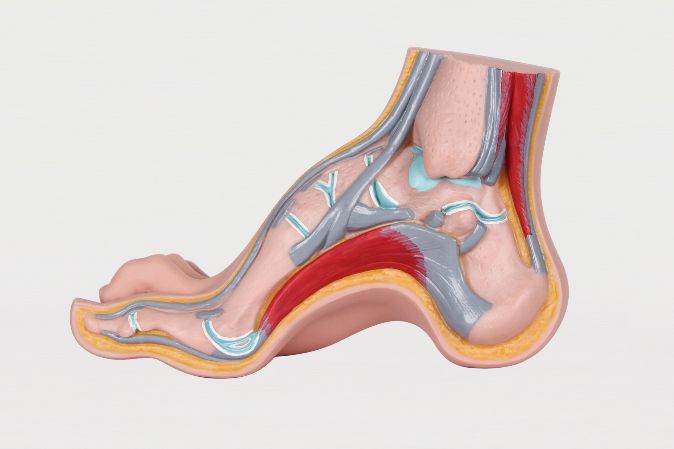
High Arches of Foot (Pes-Cavus)
Pes-Cavus, also known as high arches, is a foot condition characterized by an excessive arch in the foot’s longitudinal arch. Normally, the foot has a moderate arch that helps distribute body weight and absorb shock during walking and running. However, in individuals with Pes- Cavus, the arch is significantly higher than normal.
Pes-Cavus can be either flexible or rigid. In flexible pes cavus, the arch appears high when the individual is not weight-bearing, but it may partially flatten when they stand. In rigid Pes-Cavus, the arch remains high and does not flatten when weight is placed on the foot.
The condition can be congenital, meaning it is present from birth, or it can develop over time due to various factors such as neurological disorders, muscle imbalances, or structural abnormalities. Problems associated with high arches can vary in severity and symptoms. Some common conditions include:
Metatarsalgia: High arches can cause increased pressure on the metatarsal bones, leading to pain and inflammation in the ball of the foot.
Claw toes or Hammertoes: High arches can contribute to the development of claw toes or hammertoes, where the toes are bent in a claw-like or hammer-like shape. This can result in discomfort, corns, and calluses.
Ankle Instability: The high arch structure can affect the stability of the ankle joint, making it more prone to sprains and instability.
Stress Fractures: The increased pressure on certain areas of the foot due to high arches can increase the risk of stress fractures, especially in the metatarsal bones.
Foot and Ankle Pain: High arches can lead to foot and ankle pain due to altered foot biomechanics and increased stress on certain areas of the foot.
Achilles Tendonitis: The tightness and increased tension on the Achilles tendon associated with high arches can contribute to the development of Achilles tendonitis, causing pain and inflammation in the back of the ankle.
Cavus Foot Deformity: High arches can result in a cavus foot deformity, where the foot has an exaggerated arch and a rigid structure. This can lead to foot instability, balance issues, and difficulties with footwear.
Neuromuscular Conditions: In some cases, high arches can be associated with underlying neuromuscular conditions such as Charcot-Marie-Tooth disease or hereditary spastic paraplegia.
It is essential to consult with a podiatrist for a proper evaluation if you have high arches and are experiencing any symptoms or discomfort. A podiatrist can provide a comprehensive assessment, diagnose any associated conditions, and develop a personalized treatment plan to address your specific needs. At Phoenix Podiatry, we offer a range of treatment options tailored to the needs of individuals with Pes Cavus. Our experienced podiatrists will conduct a thorough evaluation to determine the most suitable treatment plan for your specific condition. Treatment options may include:
Custom Orthotic Devices: Custom orthotics are specially designed shoe inserts that provide arch support, cushioning, and alignment correction. They are individually crafted to address the specific needs of your high arches, distribute pressure evenly, and promote optimal foot biomechanics.
Footwear Recommendations: Wearing appropriate footwear is crucial for individuals with Pes Cavus. Our podiatrists will assess your foot structure and recommend shoes that offer ample arch support, stability, and cushioning. Well-fitted shoes with a wider toe box can accommodate the high arches and reduce discomfort.
Stretching and Strengthening Exercises: Our podiatrists will guide you through specific exercises to improve the flexibility and strength of the muscles and ligaments in your feet and ankles. These exercises can help alleviate symptoms, enhance foot stability, and promote better foot mechanics.
Low-Level Laser Therapy (LLLT): LLLT, also known as cold laser therapy, utilizes low-intensity laser or light to stimulate cellular function and promote tissue healing. It can be beneficial in reducing inflammation, relieving pain, and enhancing the healing process for certain foot conditions associated with Pes Cavus.
Joint Mobilization: Joint mobilization techniques aim to improve joint mobility and range of motion. Our podiatrists may utilize specific manual techniques to mobilize the joints in your feet and ankles, helping to restore optimal function and alleviate symptoms associated with Pes Cavus.
Trigger Point Release: Trigger points are tight knots of muscle fibers that can develop in areas of high tension or muscle imbalance. Our podiatrists can perform trigger point release techniques to release these knots and relieve associated pain and discomfort.
Padding and Orthotic Modifications: Depending on your specific needs, our podiatrists may recommend additional padding or modifications to your custom orthotics to provide targeted support and cushioning in areas of high pressure or friction. This can help alleviate discomfort and prevent the development of corns, calluses, or blisters.
Referrals for Imaging: In some cases, X-rays or ultrasound imaging may be necessary to assess the bony structures, joint alignment, and soft tissues of the foot. Our podiatrists can refer you to an appropriate imaging facility for further evaluation if required.
Regular Foot Check-ups: Regular check-ups with our podiatrists are essential for individuals with Pes Cavus. We will monitor your foot health, assess the effectiveness of the treatment plan, and make any necessary adjustments to ensure optimal outcomes.
To book an appointment or learn more about our treatment options for Pes Cavus, please contact us at 9434 2006 or conveniently BOOK ONLINE now. Our knowledgeable team is dedicated to providing personalized care and helping you manage your high arches effectively.
